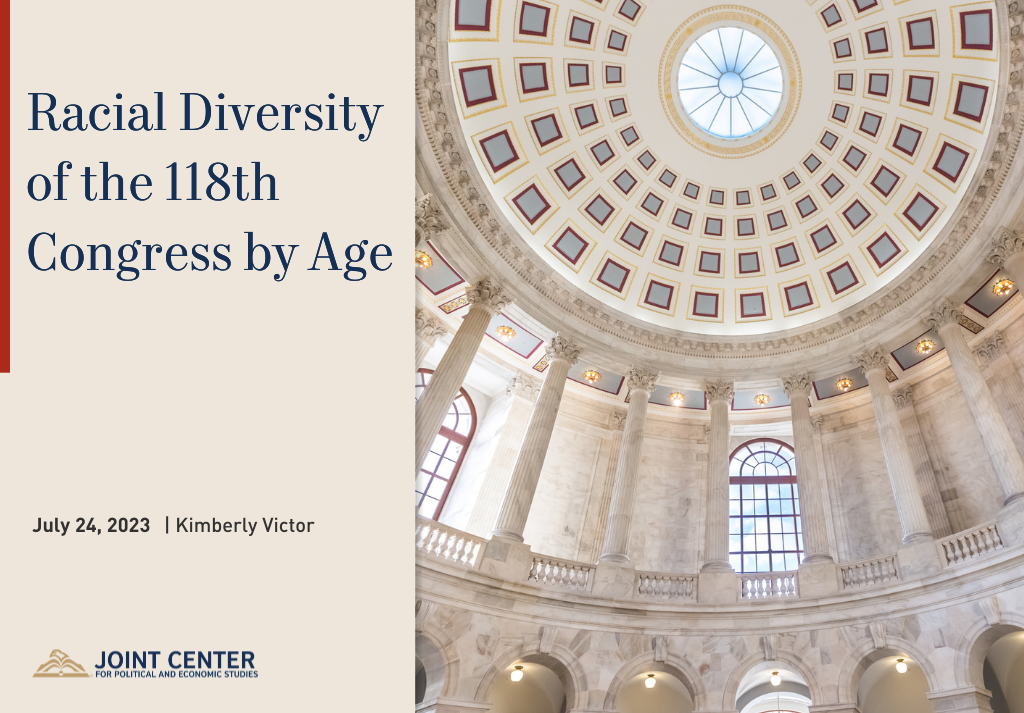Hill Diversity

Racial Diversity of the 118th Congress by Age
The age of members of Congress has generally increased since 1981, and the 118th Congress is the third oldest Congress since the late 18th century.1 The Constitution requires that a member of Congress serving in the U.S. House of Representatives be at least 25 years old, whereas the minimum age to be a U.S. Senator is 30 years old. However, the average age of members in the 118th Congress is 58.1 years old. The average age of the House of Representatives is 56.8, and the average age of the Senate is almost ten years higher at 65.6.
The increasing age of members of Congress is mostly driven by the increasing age of senators. The age of representatives in the 118th Congress actually decreased in comparison to the 117th Congress. This decline is due to a disproportionate amount of newly elected members in their 40s or younger. In addition, House members are elected every two years, providing more opportunities for younger members to be elected. In contrast, only one-third of Senate seats are up for election every two years. Therefore, the Senate’s higher minimum age requirement and longer tenure also may contribute to its older average age.
The 118th Congress also has a record amount of racial and ethnic diversity. One-quarter of the voting members of Congress identify as non-White.2 Joint Center analysis has shown that congressional members of color tend to hire a disproportionate amount of top staffers of color (top staffers being chiefs of staff, legislative directors, and communications directors).
To better understand the top congressional staff hiring patterns, the Joint Center tracks congressional top staff diversity trends for the 118th Congress. This analysis utilizes data from its tracker of top staff diversity in the 118th Congress to examine what effect, if any, the age of members of Congress has on their tendency to hire a diverse top staff.
The Joint Center analyzed the diversity of congressional top staff in personal offices by the age of the member of Congress. The analysis considers the diversity of top staff employed as of March 31, 2023, and the age of the members of Congress as of the start of the 118th Congress (Jan. 3, 2023).3 The analysis finds that in the House, the youngest group (those below 45 years old) tends to have the most diverse and most representative top staff when compared to the older groups of representatives. In the Senate, the youngest senators (below the age of 60) hired the most diverse top staff, but these top staff were least representative of the senators’ states when compared to the older two groups of senators.
Senate
The researcher grouped the 100 U.S. senators into three categories based on their age distribution. Group 1 contains 33 senators below the age of 60 years old.4 The average age of this group is 51 years old. Group 2 includes 33 senators between the ages of 60 to 69. The average age of this group is 64.8 years old. Group 3 contains 34 senators aged 70 years old and above. The average age of this group is 74.6 years old.
The youngest group of senators employs the highest average percentage of top staffers of color (18.7%), whereas the oldest group employs the lowest percentage (10.7%). Group 2 falls in the middle of both groups, employing a top staff that includes 11.5% top staffers of color. The youngest group of senators is significantly more diverse than the other two groups, having 10 senators of color including all of the Black, biracial, and Native American senators. In contrast, Groups 2 and 3 each only contain one senator of color (one Latina/o senator in Group 2, and one Asian American/Pacific Islander (AAPI) senator in Group 3). Joint Center research shows that congressional members of color tend to hire more diverse top staff.
The youngest group of senators represents states with the most racially and ethnically diverse populations. On average, just over four in 10 (40.8%) of the people in states represented by the youngest group of senators are people of color. Senators in Group 3 represent states that were, on average, 31.5% people of color. Group 2 senators represent states with the lowest amounts of diversity — an average percentage of people of color at 29.4%.
The researcher calculated a diversity score to determine how well the diversity of top staff represents the diversity of the state. This diversity score takes the difference between the percentage of top staffers of color and the percentage of people of color in the state. A diversity score of zero or higher indicates an adequate or above average representation of diversity in top staff. Group 2 has the highest diversity score (-17.8), whereas Group 1 has the lowest diversity score (-22.1). The oldest group of senators has a diversity score between Groups 1 and 2, at -20.7. This means the youngest senators have the least representative congressional top staff workforce when compared to the older Senate groups. This finding is likely attributed to the fact that the youngest senators represent the most diverse states and are only doing slightly better than the rest of the groups at hiring more diverse top staffers.
House of Representatives
The researcher divided the 435 members of the U.S. House of Representatives into five age groups.5 The first group contains 89 representatives below the age of 46. The average age of this group is 39.8 years old. The second group contains 89 representatives between the ages of 46 and 53. The average age of this group is 49.3 years old. The third group contains 83 representatives, with an average age of 57.4 years old. Group 4 contains representatives between 61 and 68 years old. This group consists of 89 representatives, and its average age is 64.3 years old. Finally, Group 5 contains representatives 69 years old and older. This group has an average age of 74.1 years old and consists of 85 members.
In the House, the oldest group of representatives represents the most diverse set of districts. The youngest group of representatives (Group 1) represents the least diverse group of districts with an average of 27.1 percent people of color. The oldest group of representatives (Group 5) represents districts that are on average 48.8 percent people of color. Group 2 represents districts that are on average 35.7 percent people of color, Group 3 represents districts that are on average 31.6 percent people of color, and Group 4 represents districts that are on average 36.6 percent people of color.
Despite representing less diverse districts, the younger groups of representatives (Groups 1 and 2) employ more diverse top staff than the oldest two groups of representatives (Groups 4 and 5). Group 1 employs the highest percentage of top staffers of color at 23.4 percent, and Group 2 employs the second highest at 20.9 percent. Group 4 employs the second lowest percentage of top staffers of color at 19.6 percent, and Group 5 employs the third lowest at 20.6%. Notably, the middle-aged Group 3 employs the overall lowest percentage of top staffers of color at 13.6 percent.
Top staff diversity trends in the U.S. House closely correlate with how racially diverse the representatives in each group are. The youngest group of representatives employs the highest percentage of top staffers of color. The youngest group of representatives is also the most diverse with 39.3 percent of representatives identifying as a person of color. Group 3 not only employs the lowest percentage of top staffers of color, but also is the least diverse group of representatives with only 19.3 percent identifying as a person of color. Group 2 is the second most diverse group of representatives at 34.8 percent people of color. Group 5 is third with just over one in three (34.1 percent) of its members identifying as people of color and Group 4 includes the fourth highest rate of diversity (21.3% members of color).
When we calculate the diversity scores of the five groups, we find that the youngest group of representatives (Group 1) has the highest diversity score (-3.8), and the oldest group of representatives (Group 5) has the lowest diversity score (-28.2). Group 2 has the second best diversity score at -14.8. Group 3 has a diversity score of -18.0, and Group 4 has a diversity score of -17.0. These results indicate that the younger representatives generally hire top staffers that are more representative of their districts when compared to their older colleagues.
Conclusion
This analysis shows that younger members of Congress tend to hire more diverse top staff than their older colleagues. In the House of Representatives, the youngest members employ the highest percentage of diverse top staff and the most representative top staff compared to the people of color in the districts they represent. In the Senate, although the youngest group of senators hires the highest percentage of top staffers of color on average compared to the other groups, it is not enough to compensate for the fact that those senators represent very diverse states. Due to this, they have the lowest diversity score of the Senate groups and are thus the least representative.
Overall, senators and representatives of all age groups have failed to hire a representative number of diverse top staffers for the areas they represent, as shown by negative diversity scores across the board. This is concerning because having diverse staff would allow Congress to more effectively represent its constituents. Across all age groups, Congress should continue to prioritize hiring diverse top staff to adequately represent their constituents and the country as a whole.
Endnotes
1 "The 118th Congress is the third oldest since 1789," Joe Murphy, NBC News, January 4, 2023.
2 "U.S. Congress continues to grow in racial, ethnic diversity," Katherine Schaefer, Pew Research Center, January 9, 2023.
3 The 118th Congress convened on January 3, 2023, when the members of the Senate were sworn in. The House of Representatives was sworn in later, on January 7, 2023, after the Speaker of the House was chosen.
4 Senator Pete Ricketts was appointed to the Senate in January to fill the vacancy left by former Senator Sasse. He is included in this analysis.
5 Jennifer McClellan won a special election to fill the vacancy left by the late Representative Donald McEachin. She assumed office on March 7, 2023, and her top staffers are included in this analysis.

